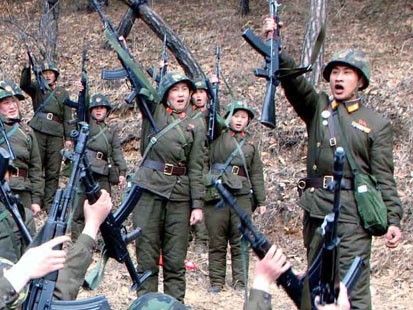8 Technology Systems Pentagon Says China Hacked from Us
Its no secret that China is hacking the ‘&&*&’ out of us. We reported last month how the U.S. feels that just last year alone, the Chinese military was responsible for 148 of the top hacks to our military and defense agency systems. So what have they gotten away with? Recently, there have been leaked photos & video of Chinese military projects that the Pentagon says are way too similar to our air, sea, & space systems to rule out coincidence. Here’s what the Pentagon says China borrowed from our closet.
1. Stealth Fighter:
Last year, reports started leaking out that china had devloped a stealth fighter that was remarkably similar to our own JSF. The maneuverability , performance, stealth and weapons systems are so exact, Pentagon officials have stated that it is almost an exact duplicate.
2. Predator Reaper Drone
Unveiled in November in southern China following seven years of development, the Yi Long drone — Beijing’s $1-million answer to the more expensive U.S. Predator and Reaper — is likely meant for domestic use and export, according to the Pentagon’s China report.
3. Z10/ (Apache Helicopters)
Since last year, the ground-warfare branch of the Chinese People’s Liberation Army has “benefited from increased production of new equipment, including the Z-10 and Z-19 attack helicopters,” . Essentially an exact =carbon copy the American Apache gunship, the Z-10 and Z-19 could provide Chinese ground troops their first reliable close air support — a major combat advantage. Interesting Note: The company, which also builds engines for American stealth fighters, pleaded guilty to the unauthorized technology transfer last summer and paid a $75-million fine, the China report notes. But it’s too late to prevent Beijing from producing scores or even hundreds of Z-10s using the illicit hardware.
4. Ground Troop Communication
For many decades the three-million-strong PLA — by far the world’s largest active army — banked on sheer mass over combat prowess, planning to overwhelm battlefield adversaries with waves of infantry and tanks instead of maneuvering for advantage.
That’s beginning to change. “To develop a new cadre of officers, the PLA is reforming its academies to cultivate junior officers proficient with and capable of leveraging technology in all warfighting functions,” the China report states. To this end, last year some Chinese army training exercises banned paper maps, forcing officers to use computerized systems for command and control — a practice that has long been commonplace in the U.S. military.
5. Space Beacons
As Chinese forces become more high tech, they increasingly need access to space-based systems to plot their movements and guide their weapons. Last year the PLA launched six copies of its Beidou positioning satellite, Beijing’s answer to the American GPS spacecraft.
Beidou allows ground, air and sea forces to determine their location on Earth with a high degree of accuracy — but only within east Asia. Beidou is a geostationary constellation that, so far, only covers China and its immediate surroundings.
The six GPS-style spacecraft that Beijing placed in orbit last year “completed the regional network as well as the in-orbit validation phase for the global network,” according to the China report. In other words, Beidou could get a lot more expansive in coming years, laying the navigational foundation for Chinese military deployments all over the world.
6. Sea Guardian
The sea, more than any other domain, is the focus of the PLA’s modernization. Last summer’s first test cruise of the refurbished Soviet aircraft carrier Lioaning symbolized Beijing’s determination to eventually dominate the western Pacific Ocean.
But at her debut, Liaoning was basically defenseless. Whereas American, French and Russian flattops sail alongside powerful escort ships bristling with radar-guided defensive missiles, Liaoning sailed alone. The PLA Navy lacks large, modern warships with the equivalent of the U.S. Navy’s Aegis radar and Standard missile.
That, however, is changing. Last year China launched the first of up to a dozen Type 052D destroyers, likely meant to equal U.S. warships’ ability to protect aircraft carriers. The new destroyer type includes what the China report describes as “the PLA Navy’s first multipurpose vertical launch system” for rapidly firing large numbers of missiles.
7. Arsenal sub
China is making huge progress with its undersea military capabilities, building several new nuclear- and diesel-powered submarines per year. China’s subs are still smaller, louder and less sophisticated than American models, but Beijing has signaled its clear intention to some day match the U.S. sub-for-sub.
That applies even to America’s most secretive submarine type, the Ohio-class guided missile subs, converted from nuclear ballistic missile carriers. Today these so-called “SSGNs” — in essence, undersea arsenals — pack 154 conventional cruise missiles plus special facilities for deploying commandos and drones.
Indications in the past year are that China wants a similar sub. “In the next decade, China will likely construct the Type 095 guided-missile attack submarine (SSGN), which may enable a submarine-based land-attack capability,” the China report warns. The new sub’s ability to strike land targets at long range from the sea would be a first for Beijing.
8.Near-shore defender
This spring, to great fanfare, the U.S. Navy deployed its first Littoral Combat Ship, a type of near-shore combatant, to Singapore, America’s newest Pacific outpost. China is countering with new coastal warships of its own.
In 2012 the PLA Navy launched “at least” six Type 056 shallow-water corvettes armed with guns and missiles — and might build up to 30 total, according to the report. The corvettes will “augment” China’s fleet of 60 brand-new, missile-armed Type 022 fast attack craft “for operations in littoral waters.”
The new near-shore combatants support a layered defensive strategy aimed at “engag[ing] adversary surface ships up to 1,000 nautical miles from China’s coast,” the report states. With its periphery secure, China can increasingly turn its military attention outward to the surrounding region … and to the rest of the world.


































































